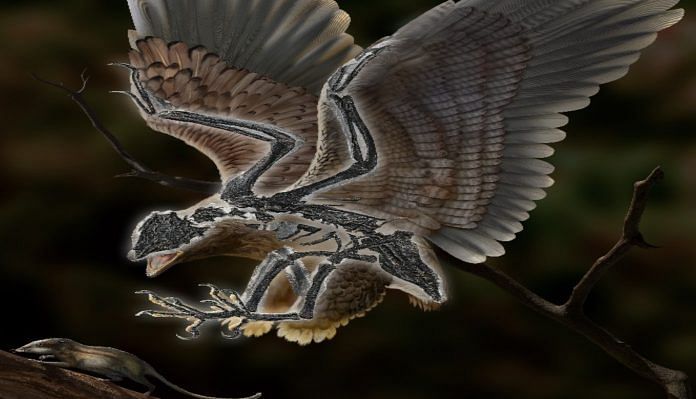New Delhi: Scientists have discovered a complete 120-million-year-old fossil bird from China that has a dinosaur-like skull and a bird-like body – a finding that may help shed new light into how birds evolved from dinosaurs.
The fossil specimen, named Cratonavis zhui, was described in a study published in Nature Ecology & Evolution. To study the fossil skull, the paleontologists from the Institute of Vertebrate Paleontology and Paleoanthropology (IVPP) of the Chinese Academy of Sciences first used high-resolution computed tomography (CT)-scanning.
They then digitally removed the bones from their rocky tomb and reconstructed the original shape and function of the skull.
The result demonstrates that the Cratonavis skull is morphologically nearly identical to that of dinosaurs such as Tyrannosaurus rex rather than being bird-like. Read more
Also Read: Scientists find fish that stress eat their own babies & spot a black hole gobbling up a star
Genetically modified worms use sunlight to live longer
In a new study, researchers have used solar power to extend the life of the roundworms — paving the way for identifying new ways to combat age-related diseases.
The team from the University of Rochester showed that genetically engineered mitochondria can convert light energy into chemical energy that cells can use. This ultimately extended the life of a microscopic roundworm C. elegans,
The findings, published in the journal Nature Aging, shed light on important mechanisms in the aging process.
Mitochondrial dysfunction is a consequence of aging. Often referred to as cellular power plants, mitochondria are organelles that use glucose to produce adenosine triphosphate (ATP), the compound that provides energy for key functions in the cell, such as muscle contraction and the electrical impulses that help nerve cells communicate with each other.
Production of ATP is the result of a number of reactions made possible by the exchange of protons across a membrane that separates different compartments in mitochondria. The efficiency with which this occurs is called the membrane potential.
Known to decline with age, the membrane potential is a topic of great interest in the scientific community because of its potential role in a number of age-related diseases, such as neurodegenerative disorders.
The researchers genetically engineered C. elegans mitochondria to include a light-activated proton pump obtained from a fungus. When exposed to light, the proton pumps moved charged ions across the membrane, using the energy from the light to charge the mitochondria.
This process increased membrane potential and ATP production and resulted in a 30-40 per cent increase in the lifespan of the roundworms. Read more
Methane emissions offset carbon uptake in algal habitats
Bladderwrack forests — brown sea algae that take up significant amounts of carbon dioxide — also emit huge amounts of methane, offsetting its carbon sequestration benefits, researchers have found.
Researchers from Stockholm University and the University of Helsinki measured greenhouse gas fluxes between the water surface and atmosphere outside the Askö Laboratory in Trosa over a whole year.
While the measurements confirmed that mixed vegetation and bladderwrack forests in the coastal zone do take up significant amounts of carbon dioxide from the atmosphere, it is offset by methane fluxes from the water to the atmosphere.
The uptake of carbon dioxide from the atmosphere over the bladderwrack habitats added up to 0.52 tons of CO2 per hectare and year, which can be compared with 0.71 tons of CO2 per hectare and year for areas with mixed vegetation.
However, as methane is a stronger greenhouse gas than carbon dioxide, the net carbon uptake is reduced to 0.38 tons and 0.46 tons of carbon dioxide equivalent per hectare and year for bladderwrack and mixed vegetation sites, respectively.
Coastal ecosystems can take up and store large amounts of carbon dioxide from the atmosphere, so-called “blue carbon”. Restoring such ecosystems could therefore be an important nature-based solution to mitigate climate change.
Well-known blue carbon ecosystems include mangroves, seagrass meadows, and salt marshes. However, more recently, it has been suggested that also macroalgae, such as the bladderwrack (Fucus vesiculosus) — commonly found in the Baltic Sea — can take up large amounts of atmospheric carbon. If this carbon is, for example, exported to and sequestered in the deep sea, macroalgae could be one of the most important blue carbon ecosystems globally.
The research shows that it is important to fully understand such microalgal environments before they are implemented in climate change mitigation strategies. Read more
Hubble Telescope detects ghostly light from stars
Using the Hubble Space Telescope, scientists have detected ghostly hazes of light from ancient wandering stars.
In giant clusters of hundreds or thousands of galaxies, innumerable stars wander among the galaxies, emitting a ghostly haze of light. These stars are not gravitationally tied to any particular galaxy.
The phenomenon has been a mystery for scientists. Several competing theories about these scattered stars include the possibility that the stars were stripped out of a cluster’s galaxies, or they were tossed around after mergers of galaxies, or they were present early in a cluster’s formative years many billions of years ago.
However, the new Hubble observations suggest that these stars have been wandering around for billions of years, and are not a product of more recent dynamical activity inside a galaxy cluster that would strip them out of normal galaxies.
The survey included 10 galaxy clusters as far away as nearly 10 billion light-years. These measurements must be made from space because the faint intracluster light is 10,000 times dimmer than the night sky as seen from the ground. Read more
(Edited by Uttara Ramaswamy)
Also Read: How new DNA software — used to create smallest pottery — will help create solar cell molds






